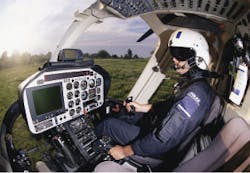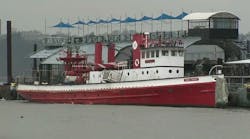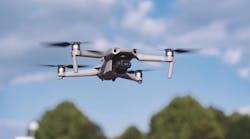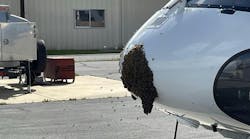It comes as no surprise to discover that the police helicopter can be safely labeled a force multiplier. In fact multiple studies over the years have shown that criminals are statistically caught more often when the aerial unit flies over scene.
It also should be no astonishment to look at the bottom line and find the cost to maintain that unit can run an imposing figure; this sum can hover its cost high above less expensive, but no less valuable, public safety ventures.
With so much of an investment, what can be done to ensure those finances are best utilized for mission?
Representing a rough cross section of two different environments, the Metro Air Support Unit of the St. Louis County (Mo.) Police Department and the Air Support Division of the Los Angeles Police Department both respond to a large area's day and night calls.
The Metro Air Support Unit has multi-jurisdiction with the St. Louis Metropolitan PD, St. Louis County PD and St. Charles Sheriff's Department. The unit uses a combination of helicopters and a fixed wing aircraft.
"Due to funding sources, we formed this multi-jurisdiction to maintain and to keep the operation afloat," says Sgt. Kerry Wisdom, supervisor of the Metro Air Support Unit, St. Louis County PD. "Each [jurisdiction] contributes funding to the unit and by doing so, that keeps our operation going."
Responding to about 45,000 calls for service every year, Los Angeles has a bit of a different scenario. At 19 helicopters and one fixed wing, the department, says Capt. James Miller, is the largest municipal law enforcement agency in the world.
Yet, money remains the great equalizer. Regardless of budget size, every choice is affected by funding.
No one can argue the effectiveness of aerial support in law enforcement. And, as such, an agency may find it beneficial that spending some money might lead to upping its efficiency. After all — the devil is in the details.
As vice president of technical operations for Helinet Technologies and its parent company Helinet Aviation Services, J.T. Alpaugh compares the typical capabilities from law enforcement's air support to that of electronic news gathering — the aerial images we see on the nightly news and on the major news media.
"I've heard for years and years from airborne law enforcement from the federal, state and local governments: Why can't we do what the media does? Why can't we get those types of pictures? And why can't we move these pictures over long distances?" Alpaugh says.
His company offers law enforcement agencies a solution in being able to take a look at how they may benefit from new technologies for air support, understanding that each agency's mission can lend to unique situations or special needs.
"We don't go in and tell agencies what they need, a lot of these agencies know exactly what they want and what they need," he says. "We're here technologically to help in whatever manner they need help with. It's very flexible in the sense that if [the agency] doesn't need it, we don't provide it — but if they do need it, we can."
Right tool = Right answer?Despite any geographic differences, the Los Angeles and St. Louis air support units utilize similar basic tools for sighting suspects, mapping and communications.
"Some of the technology we have is a search spotlight, a forward-looking infrared system, a moving map system, a GPS and more to assist the tactical flight officer (TFO)," Wisdom says.
According to Miller, Los Angeles is able to supply its fleet with these, plus "downlink capabilities when we're over major demonstrations and big community events." He adds this provides them the ability to not only record, but downlink to incident commanders.
The tricky part, Alpaugh says, is getting that downlink to the ground and disseminating it to where the agency needs and wants it. "People a lot of times may think we simply just downlink specifically to the ground officer that's next to the incident," he says. While this is possible, sometimes the agency might want the feed sent to headquarters — 20 miles to 100 miles away — where it can be put into a network and distributed how they choose from there.
"It's up to [an agency's] imagination," Alpaugh adds.
However, this capability also leads to another trouble: using the same frequency as the news media. This creates an unfortunate race to the scene, one in which law enforcement shouldn't feel rushed to capture this digital flag for public safety.
St. Louis chose to avoid this issue: its TFOs connect with the ground by radio, directly informing officers of the situation as it progresses. Currently, Los Angeles is looking to go over its local news media's metaphoric digital head in the progress of upgrading its fleet to a higher megahertz frequency to give law enforcement and the media the ability to act independently.
With the advent of high definition (HD) technologies, sometimes the issue is what the message includes, as well as how it's getting to the ground. If the TFO transmits the video feed, air support now has the option to upgrade its bird's eye view with a better pair of glasses.
In live demos, Alpaugh exhibits the possibilities of what HD can offer officers. He displays imagery from surveillance 3,000 feet in the air and shows that commanders could then recognize the person and see that the item in the suspect's hand is not a cell phone but a weapon, and the tattoo on his left forearm.
"If anybody needs that detail, it's law enforcement," he adds. "You can more easily make life-saving tactical decisions based on higher detail imagery if you have it than if you don't."
A higher-resolution feed coming in to commanders, officers, mobile command units or headquarters means a larger data size. Alpaugh's Helinet suggests agencies compress the footage and use a microwave downlink system to disseminate the information. According to Wisdom, the St. Louis Metro Air Support Unit is currently researching such a system.
A downlink system must consist of at least one receive site and have the capability to transmit secure video. In his experience, Alpaugh goes beyond and looks at how the agency will steer that receive antenna to track the helicopter with automatic tracking technology, how that information is downloaded into the station and displayed onto HD monitors, how the agency wishes to record the video, and whether it wants to send the signal through an IP stream. "That's how electronic news gathering works," he says. "Television stations can have multiple receive sites to simultaneously bring in [the video] from microwave trucks on the ground and the helicopters.
"There are so many details that make the difference between [the equipment] becoming successful and it becoming hanger trash."
The human influenceNo matter how high tech the equipment, getting the right man in the cockpit can make all the difference. High-tech devices do not automatically make the mission a success; most of aerial support can be done through the initiative of the TFO. "Most of our surveillance is done just by looking out the window," Miller says.
"The key to success of aerial surveillance, just like the key to successful police work on the ground, is having the right person in position — the motivated person that is going to be out there looking for the criminal on a regular basis," he adds. "Technology in the cockpit can enhance a pilot's performance and can make it so they can do more things, but you have to have that right individual in the cockpit."
Another part of the successful mission is training that "right" individual with the right tools for the job. For example, Los Angeles has an extensive initial and continuous training program. LAPD starts its pilots with a 200-hour course, and TFOs a four-month training program. Of the four months, the trainee spends one month on "loan" for the department, which causes an 85-percent wash-out rate. Afterward, the trainee must pass an additional three months of on-the-job instruction. The department also puts on a 40-hour one-week police officer standards of training certified class, but it is not required for the program.
Continuous training for the Los Angeles PD consists of learning how to use upgraded equipment, a TFO "check ride" every six months with the chief TFO, and a pilot "check ride" every 90 days to demonstrate the ability to operate the aircraft in normal and emergency situations.
Law enforcement agencies run the risk of their purchased product or technology not accomplishing as promised and turning failed results. Alpaugh sees these failures as the result of one of three instances: (A) Someone didn't know how to use it properly; (B) It failed and never got fixed; or (C) Air crews aren't using the technology or are not recurrently trained. "When the big incident happens and they have to use it, it's not being used properly and winds up taken out of the aircraft because of weight," he adds.
Piloting the priceLifting off, an investment in aerial support shouldn't be taken lightly. "[Agencies should] make a commitment not just to the cost of the helicopter, but really a commitment to using it as close to continuously as possible, which means flying more than one helicopter and having more than one flight crew — which is extremely expensive," Miller says. He explains that using it as much as possible maximizes the investment, because the more the helicopter is in the air, the more successful the TFOs are going to be in catching criminals and keeping communities safe.
St. Louis uses its multi-jurisdiction to help finance its Metro Air Support Unit; however, according to Wisdom, "it's not set up to be able to fund all of the projects to keep the helicopters and flight operations going alone." St. Louis recently took delivery of a MD500E model helicopter, valued at more than $1 million, through Homeland Security grants and is currently trying to purchase a new infrared unit and spotlights as well.
Similarly, Los Angeles occasionally obtained some of the technology on board of its helicopters through NIJ grants and other state grants.
With the multitude of technological options available for aerial support, deciding which aspect to zero in on can be daunting. "You have to try and figure out what your highest needs are," Wisdom advises.
Alpaugh agrees, "It can get expensive, especially when you're dealing with HD technologies."
Regardless of whether the TFO is looking at the latest computer tablet monitor or peering out the window, the helicopter affects the criminal behavior as much as it does the budget. "[If] the criminal knows that there are eyes on them … they'll either flee and try to hide … or stop what they are doing and wait for police to arrive," Miller says.
"Generally it interrupts whatever the criminal activity was and makes it safer for the people on the ground." That, for all its cost, is most definitely worth the price for an eye or two in the sky.



